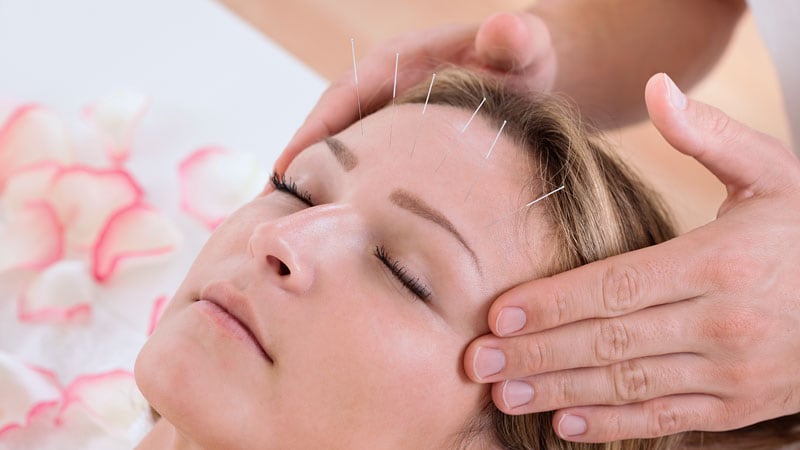Acupuncture is an effective treatment for anxiety in patients with Parkinson’s disease (PD), results of a randomized controlled trial show.
Both sham and real acupuncture eased PD-related anxiety at the end of 8-week treatment, but only real acupuncture had an enduring effect at 2 months after treatment ended.
The early effect with sham acupuncture in this Chinese population is not surprising, the researchers point out.
“In China, acupuncture is a traditional treatment method with a long history, which has a high degree of cultural identity among Chinese patients,” Li-xing Zhuang, PhD, with Guangzhou University of Traditional Chinese Medicine in Guangdong, China, explained in an email to Medscape Medical News.
Therefore, the patient will typically trust acupuncture as an effective treatment, which leads to the therapeutic effect of the sham needle at the end of the treatment.
However, while acupuncture may produce a “placebo effect in a short time, this effect will disappear with time, while the therapeutic effect remains at a stable level,” Zhuang said.
“Based on our results, acupuncture should be recommended for anxiety in PD,” Zhuang added.
The study was published online Sept. 21 in JAMA Network Open.
Common Symptom With Limited Options
Anxiety is common in patients with PD but targeted treatment for anxiety related to PD is limited.
The findings are based on a randomized, double-blind trial of 64 men and women with PD and anxiety, in which half received real or half received sham acupuncture three times per week for 8 weeks. The primary outcome was the Hamilton Anxiety Scale (HAM-A) score.
At the end of treatment, the mean change from baseline in the HAM-A score was not statistically significant between the real and sham acupuncture groups (-4.38 vs -4.16; 0.22 difference; P = .62).
However, at 2 months after the end of treatment, the real acupuncture group had a significant 7.03-point greater reduction in HAM-A score compared with the sham acupuncture group (-7.56 vs -0.53; P < .001).
Zhuang noted that the difference generated by real acupuncture is not only statistically significant, but also reaches the “minimum clinically important difference (MCID) value, so the results of this study are clinically significant.”
Because there is no consensus on MCID of HAM-A, the researchers used an anchor-based method to calculate the MCID.
A similar percentage of real (65.6%) and sham acupuncture groups (62.5%) reached the MCID of 4 and showed clinical improvements in anxiety at the end of treatment.
At the end of the 2-month follow-up period, 86.8% patients in the real acupuncture group reached the MCID compared with only 6.4% patients in the sham group.
There was also improvement in secondary outcomes with real acupuncture at 2 months follow-up, including scores on the Unified Parkinson Disease Rating Scale (UPDRS), 39-item Parkinson Disease Questionnaire (PDQ-39), and serum levels of the adrenocorticotropic hormone (ACTH).
A Buffer Against Anxiety
Reached for comment, Shaheen Lakhan, MD, a neurologist and researcher from Boston, Massachusetts, who was not involved in the study, said the finding that after 8 weeks that sham and real acupuncture produced an anti-anxiety effect in a 100% Chinese population with tremendous cultural expectation bias does not surprise him.
“I cannot say the same with the follow-up period — a full 8 weeks after treatment stopped — anxiety was re-measured and there was a clear, significant clinical improvement between the real acupuncture and the sham groups,” Lakhan told Medscape Medical News.
“The sham group’s anxiety returned to baseline levels before any intervention, while the real acupuncture group not only had sustained anti-anxiety response, but made even more gains after stopping treatment,” he noted.
Lakhan said it is important to note that anxiety is fundamentally a disorder of cognition and autonomic function with a bidirectional relationship.
Patients with anxiety have cognitive inflexibility (inability to adapt to the environment, stimuli, threats) and autonomic dysregulation (hyperarousal of heart rate, blood pressure, and other physiology), and disturbance of either make the other worse.
“In certain neurodegenerative disorders like PD, the autonomic nervous system is particularly and progressively impaired causing failures to adapt. Acupuncture, I postulate, actually trains that flight-and-fight (parasympathetic and sympathetic) nervous system so it can buffer against anxiety,” Lakhan said.
“This study was not designed to prove my postulate. Most importantly, they did not collect measures of autonomic function at baseline nor after treatment,” he commented.
“Nonetheless, it is the pilot data that supports further clinical research to eventually prove (or disprove) that standardized acupuncture is an effective treatment for patients with anxiety and underlying progressive neurological disease,” Lakhan said.
The study was supported by the National Natural Science Foundation of China, the National Administration of Traditional Chinese Medicine, and the Guangdong Administration of Traditional Chinese Medicine. Zhuang and Lakhan reported no relevant disclosures.
JAMA Netw Open. Published online Sept. 21, 2022. Full text.
For more Medscape Neurology news, join us on Facebook and Twitter.
Source: Read Full Article
